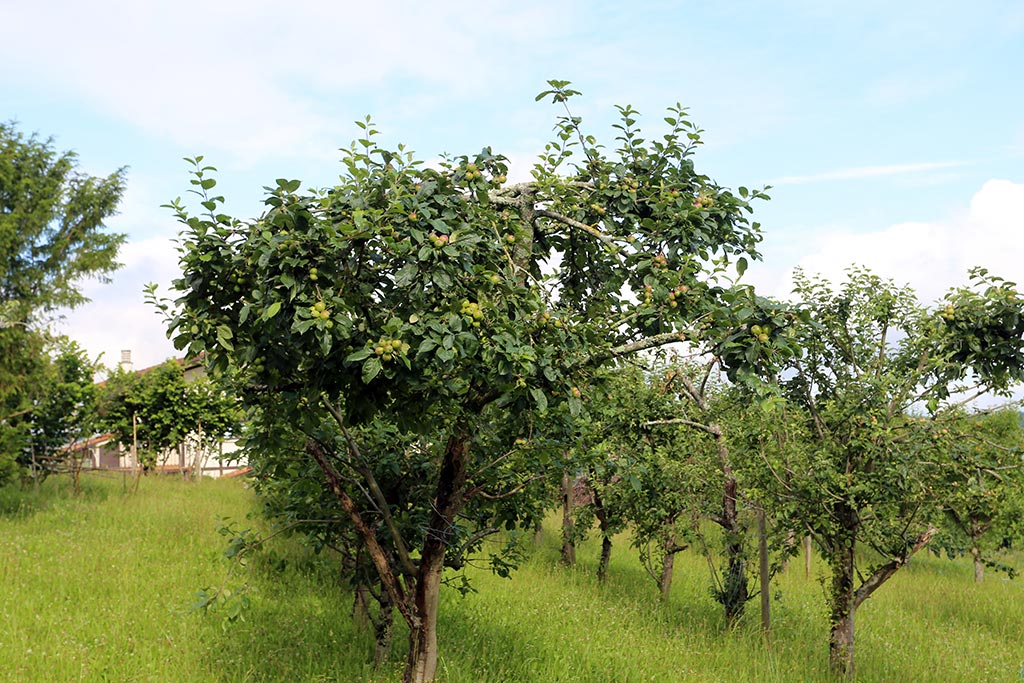- Home page
- Tourism
- Discover
- Visiting the Basque Country
- [Spanish Side] Guipuscoa - The coast and the azure blue sky!
- Visiting the Basque Country
- Discover
- Tourism
Guipuscoa - The coast and the azure blue sky!
Automatic translation
Guipuzkoa is an attractive Basque province. Its coasts (along with those of Biscay) are among the most beautiful in Europe. Set with opulent villas, which rival the brilliance of the small, colourful and picturesque town houses, you have to plunge into the small ports, the alleys, the bars to feel the heart of this region beating. You also have to go and meet its inhabitants, the Basques who are jovial, whole and always ready to party.
Hondarribia
Hondarribia is Hendaye 's neighbour, on the other side of the Bidasoa River which flows into the Bay of Chingoudy (Txingudi). It is a beautiful seaside resort, with the attractions of a mountainous area, legs in the water. The ancient city centre and its fortifications remind us that it is the gateway (the Santa Maria gate near the church of the same name) to the Kingdom of Spain since Charles V.
It is a place that is very visited by the French who love to come and spend a day at the beach and taste the delicious Basque cuisine that flourishes in the many Pintxos bars and quality restaurants in the city.
Near the coast, the port atmosphere in the Marina district (the marina) is pleasant. It is one of the largest fishing ports in the region.
Take a walk along the Butrón Passage which leads to the banks. You are facing the mouth of the Bidasoa and Hendaye opposite (French side). Moreover, if you want to go there by taking a nice walk, take the path of the bay, which starts from Hondarribia, to Irun, then Hendaye (14 km one way). There is an authentic atmosphere in Hondarribia, even if it is a tourist destination, it has nonetheless kept its charm.
Take a stroll to see the fortified ramparts, the city center and its colorful houses with charming balconies. The city hall is majestic, as are the palaces and charming townhouses. On the Place des Armes, look up at the hotel that has taken place in the former castle of Charles V. Visit the City Interpretation Center, which is housed in the former powder magazine.
Ipar Adventure
Ipar Adventure
Ipar Adventure: Your Nature Adventure in the Basque Country and the Pyrenees IPAR Adventure is positioned as the ...
467 m - Fuenterrabía
Relais Thalasso Serge Blanco
Relais Thalasso Serge Blanco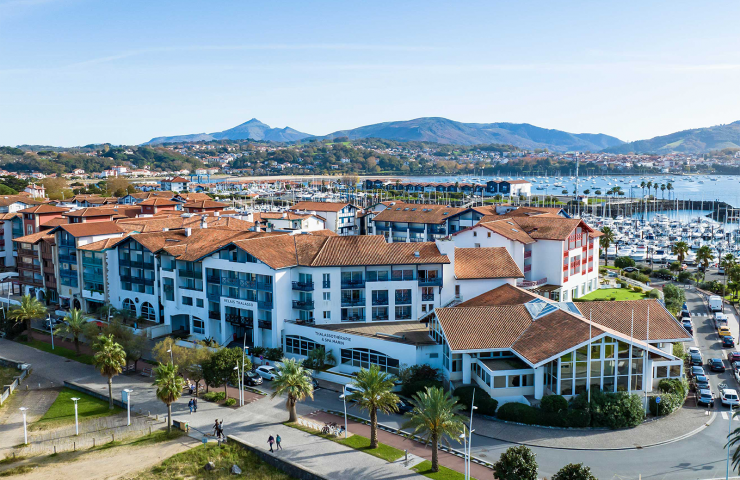
Immerse yourself in the heart of a world dedicated to relaxation, where thalassotherapy and beauty treatments come ...
1,2 km - Hendaye
Explore Océan
Explore Océan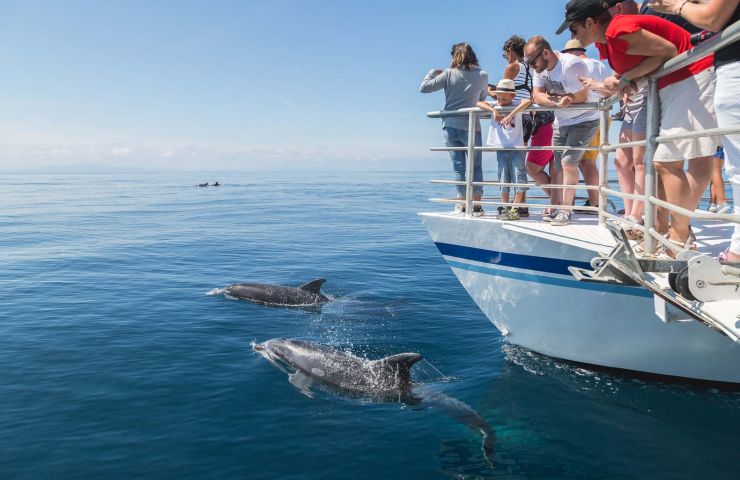
Embarking with Explore Ocean aboard its catamaran Atalaya will be an unforgettable experience Cetacean Expeditions ...
1,2 km - Hendaye
Irun
Further south, you go to Irun, also a border town with France. It seems quite recent, but it actually contains 2,000 years of history. First of all, there is the Oiasso Roman Museum, which is an archaeological museum, laying bare all the Roman activity that the city has known. Objects, customs, lifestyles, food, work tools, it is a fabulous museum teeming with cultural activities.
In Irun, a beautiful beach on the estuary will satisfy your desire for sunbathing and the market and shopping streets will satisfy your shopping desires. In the center, go and see the town hall, an emblematic building of the city. There is also the church of Santa Maria del Juncal and further out of the city, a hermitage (Ama Xantalen) which houses a small museum.
Outside Irun there are several large shopping centres, popular with the French, as some things like alcohol are much cheaper there... Be careful not to exceed the customs limits!!!
Ciclos Jaizkibel
Ciclos Jaizkibel
Shop, repair workshop and bicycle rental in Irun, Hondarribia and Hendaye The Ciclos Jaizkibel store located in Irun ...
330 m - Irún
REIKI BOLKI
REIKI BOLKI
Reiki-Bolki is first and foremost a meeting place where each person is received with kindness and authenticity; it ...
1,4 km - Hendaye
Venta Peio
Venta Peio
No queues, no hassle, with the essentials at your fingertips: this is what Venta Peio in Irún offers, a practical, ...
2,1 km - Irún
Errenteria and the Aiako Harria Natural Park
Further south of Irun, you will go to Errenteria at the entrance to the bay of Pasaia to stroll through its old town, vast and offering a beautiful view from the fort of San Marcos. This one protected the nearby city of San Sebastian. It is a city with many faces. On one side, the old medieval quarter has retained its charm, then a more modern quarter full of Basque houses, and finally there is a clearly industrial quarter.
Errenteria is a happy and festive place in the summer and on weekends. To recover from the wild evenings, why not take a trip to Oiartzun, further south, gateway to the Aiako Harria Natural Park for hiking and the amazing visit of the Arditurri mines in a very old geological formation unique in the Basque Country. You can even go there by bike or on foot from Errenteria by taking the Arditurri greenway. The more athletic will go to San Sebastian.
There are two small municipal museums to see in Oiartzun: a geological interpretation centre and one on popular music.
Passaia Bay
We arrive at the beautiful bay of Passaia (Ria de Passaia). It shelters charming little nooks and crannies, ancestral fishing and trading ports, all around the waters of the sea which rush in here.
To the east of the bay, there is Pasaia Donibane, from where La Fayette set sail for America on his ship La Victoire. It is also a famous favorite of Victor Hugo, who called it a " little radiant Eden ". It makes you want to go for a walk along the bay. The coast is unspoiled and home to a multitude of birds.
At the foot of the mountains, the houses are beautiful and seem to cling to the cliff. Water taxi trips allow you to reach the other side of the Ria for a small fee. The small fishing villages have kept their charm, as well as the old village of Pasaia where you can see the Casa de Victor Hugo where he stayed in 1843. It is a pleasure to eat on the terrace, on a beautiful day, before or after a walk along the bay.
To the east, pass through Lezo , crossed by the Oiartzun River which flows into the bay before joining the sea. The Gothic Basilica of Santo Cristo is the jewel of the city, all around it is organized the historic center with a mountainous backdrop. Mount Jaizkibel promises beautiful hikes with interesting views.
Just before San Sebastian: Apples and heritage
We are getting closer to San Sebastian, just a little more patience, there are some nice things to see and drink on the road!
Astigarraga is the region par excellence of cider. The real Basque cider, the one that is acidic and quite alcoholic. The one that is consumed accompanied by Txotx (traditionally a small meal to go with it, bread, eggs, dried cod). There are plenty of apple orchards all around the city. The real cider houses are places where the farmers take care of their orchards for a good part of the year and start making cider a few months a year in winter (mid-January / end of March). This is when you can taste the cider, directly at the grower/producer, like the Basques.
From Astigarraga to Hernani, there are a number of apple orchards to visit and feast in. Be careful, most of them are not open all year round, like the cider houses that we know, which are in fact more specialized breweries.
July 26th is the big cider festival in Astigarraga and it is an event not to be missed.
Apart from apples, in Astiagarraga you will find, if you are interested in local lifestyles, the Santiagomendi ethnographic park. There is also a beautiful garden, the Murgia public park and of course, the cider museum, the Sagardo Etxea with a visit to the apple orchard, tastings and explanations of the manufacturing processes.
Hernani is an industrialized city that has managed to keep some of its charm. A visit to the old town is interesting.
For lovers of swimming pools and water games, a very large water park of 25,000 m² is open in the summer season "Jolas igerilekuak".
The city has set up some nice walking routes throughout the municipality.
Further south is Urnieta, a small town with a rich heritage, surrounded by green hills, rarely visited by tourists. The Camino de Santiago passes through it and there are many historic buildings and an archaeological area.
Marizulo Cave is close to many megalithic features from the Bronze and Iron Ages. You can reach it after a hike.
Further south, Andoain, in the Leitzaran Valley, is also surrounded by parks and beautiful mountains. Note the presence of a dynamic cultural center, the Bastero.
San Sebastian
We arrive in San Sebastian (Donostia).
Such a pretty seaside resort, that many people go there for a day or a weekend from the French Basque Country.
Chic and relaxed, cool and deep at the same time, it is an interesting city and renowned for the quality of its shops and restaurants. It has been the capital of Gipuzkoa since 1854, when it opened up to the beautiful world with the fashion for sea bathing.
People come here to walk along the bay and enjoy the magnificent viewpoints, to lounge on the beautiful beach of La Concha, to marvel and naively imagine themselves ("can you imagine if we lived there??") in front of the facades of the luxurious 19th century hotels and houses. Winter and summer alike, Donostia is a lively, young and very popular city. The quality of the cultural infrastructure is such that the scene is rich and attractive. Concerts, shows, sporting events, there is always something to see!
Stroll through the old town, along the ramparts, climb up to the Motte Castle, return to the large Plaza de la Constitución and take a break to taste the city's pintxos .
Between the mountains and the beach, San Sebastian offers breathtaking views of the bay and to do this, start by taking the funicular to Mount Igueldo where there is a fun little amusement park dating from 1912. Go back down to take a walk to Ondarreta beach, there is the Miramar Palace and its gardens, facing the sea.
Then head to Gros, the popular and young neighborhood, by the sea, for shopping and a drink. Continue to Zurriola Beach, where its many surfers offer you a beautiful spectacle. There are other less exposed beaches, the beaches of Santa Clara Island.
Do you like museums ? You won't be disappointed, San Sebastian has plenty.
- The San Telmo Municipal Museum, in a former Dominican convent, is a museum about the history of the city.
- The Balenciaga Museum is dedicated to the designer of the same name.
- Albaola is the Basque Maritime Heritage Museum, where real shipbuilding takes place. There is also a carpentry and navigation school.
- There is also the naval museum on the same subject but with a more historical angle.
- At the Château de la Motte, there is the History Museum with modern and interactive scenography.
- An original museum, if ever there was one, the Museum Cemento Rezola (cement museum) questions us about the place of cement in our lives and our civilization...
- Children will enjoy the Aquarium as well as the Eureka Science Museum.
- Football fans young and old will be delighted to visit the city's football club museum, the Real Sociedad Museum.
Salt Room San Sebastián
Salt Room San Sebastián
Salt Room Donostia – Salt Caves Salt Room Donostia is a center specialized in halotherapy, a natural therapy that ...
2,1 km - San Sebastián
Abba Apartments Playa de Gros
Abba Apartments Playa de Gros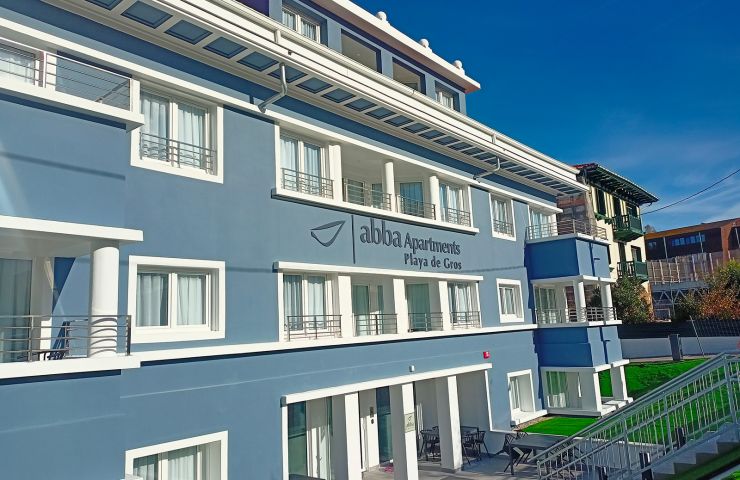
Located in one of the most emblematic towns in the Basque Country, Abba Apartments Playa de Gros offers apartments ...
2,5 km - San Sebastián
Abba San Sebastian
Abba San Sebastian
We welcome you to the Abba San Sebastián Hotel, a unique boutique hotel in Donostia-San Sebastian, where you can ...
2,9 km - San Sebastián
Read about San Sebastian:
The heritage of San Sebastian
The heritage of San Sebastian is remarkable, crossed by the Urumea River, spanned by several bridges that separate the old town from the more recent part. It has an irresistible seaside charm from the beginning of the last century.
We have imagined a little circuit to discover some of these wonders:
- Depart from the La Perla thalassotherapy center on the edge of the beautiful Concha beach.
- Continue to the Cathedral of the Good Shepherd, dating from 1897 and built with sandstone from Mount Igueldo.
- Cross the Maria Cristina Bridge and its 4 obelisks, follow the river and cross the Santa Catalina Bridge with 4 arches again.
- Continue to the beautiful Victoria Eugenia Theatre, one of the most important in the country, built in the early 19th century in neo-Renaissance style.
- Then continue towards the Kursaal Palace and its two large contemporary cubes, it is the congress center and it faces Zurriola beach and the Gros district.
- Retrace your steps to go to the magnificent Basilica of Saint Mary of the Choir which is the oldest church in the city, dating from 1750.
- Then return to the beach to end your short visit at the town hall, which is located in a former casino.
You have done about 4 kilometers.
As you will have noticed during your wanderings, the city is an open-air museum. Several monumental sculptures are scattered there, such as the Wind Comb, Empty Construction, the Bakearen Usoa, etc.
San Sebastian is not a city made for cars , which clog up the roads at night. It is therefore best to park in the underground car parks to avoid any hassle!
Please note : since January 2025, any vehicle registered outside of Spain will have to register in advance to enter this area. If you don't do so, you risk a hefty fine...
Discover the city on a guided tour, to learn everything about the heritage in a lively way and if you want an English accent, take a convertible “ hop on hop off ” bus ticket (red like in the United Kingdom!).
Orio, Zarautz and the coast
We continue west towards Orio, a pretty fishing village and the nearby seaside resort of Zarautz. Very lively in the summer, Orio is at the mouth of the Oria River. It is a stopover on the way to Santiago de Compostela.
You will enjoy visiting the old quarters (Goiko Kale) from the 12th century, which are easily done on foot since everything is quite close together. As you get closer to the Cantabrian Sea, you will see beautiful cliffs and the beaches of Antilla (near the mouth of the river) and Oribazar (on the other side).
In Orio, do not forget to try the sea bream which is a specialty, deliciously cooked in the restaurants near the port, as well as the eel. Like many coastal towns, Orio has its mountains, the Talaimendi.
A little further south, there is the urban municipality of Lasarte-Oria, which is lively and well populated. It is crossed by the Oria River and enjoys the proximity of Orio for the seaside side. But Lasarte-Oria alone has many attractions: it is well provided with hotels, restaurants and an interesting concept of "open-air museum". It is a guided tour of the city, in the form of a brochure available for download or at the tourist office, to see the main points of cultural, historical and artistic attraction of the city.
Marco Topo
Marco Topo
Marco Topo is an exciting interactive game designed for children and families who want to discover Zarautz in a fun ...
Zarautz
Zarautz Surf House
Zarautz Surf House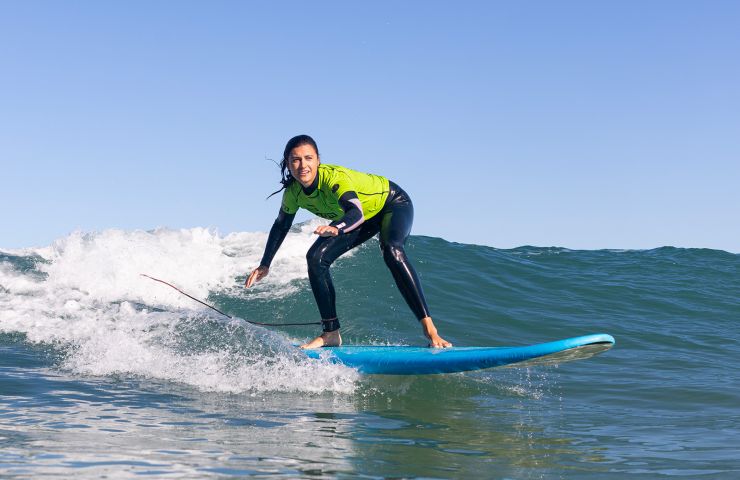
Discover the passion for surfing at our school located in the same Surf House! We offer classes for all levels and ...
321 m - Zarautz
Thalasso Villa Antilla
Thalasso Villa Antilla
The Villa Antilla Wellness & Thalassotherapy Centre in Orio invites you to a unique sensory immersion by the sea. ...
3,6 km - Orio
Small fishing ports
A little to the west is the pretty little town of Usurbil, where it is pleasant to walk to enjoy the heritage, such as the church of San Salvador, the house Casa Saroe and also a baroque palace: Atxega and that of Sarobe.
Walk behind the pediment to see a beautiful fresco of an imposing size. A little outside the city, there is the hermitage of San Esteban. If you like small eels, which are called elvers, this is where you have to taste them. It is a very regulated fishery, for a luxury and delicious product, which unfortunately suffers too much pressure on its populations. Enjoy it sparingly, in this picturesque place where it is conscientiously fished.
In Usurbil, we also like to drink cider ! From January to May (and by extension, all year round now), it is the high season and you should not deprive yourself of it, because it is delicious!
Pagoeta Natural Park
You arrive in the town of Aia, which is in the heart of the Pagoeta Natural Park. A haven of nature and beauty.
If you like hiking, this is the place to put down your suitcases for several days. It is a family place where the paths are designed for everyone, with good signs and distances to please everyone. A string of small hamlets make up the commune.
To enjoy the park, head to the visitor center, in a Basque farmhouse, which will offer you an ethnological exhibition as well as all the information to enjoy the fun and educational side of the park. Dolmens, ancient deposits, caves and domestic fauna (native cows and Pottoka ponies) greet you (from afar all the same…).
Don't miss the Agorregi forges, a large complex with 4 mills and everything needed to explain to visitors the transformation of ore into iron. For lovers of crafts and old trades, it is a treat. There is also a botanical garden for plant lovers: The Iturrarán Botanical Garden.
We tested a hike in the Pagoeta Natural Park for you.
Spa resorts and coastal towns
We go back up towards the coast to Zestoa, a real spa resort known since the 18th century. In addition to its springs, the town centre is pleasant, like the Lili Palace which can be visited. The surroundings of the town are rich in prehistoric artefacts, discovered during excavations. There are also decorated caves, including that of Ekainberri, which can be visited and offers workshops for children (it is a facsimile of the cave which is closed to the public).
On the coast, Zarautz is a popular tourist destination. The city has understood its attractions well. It offers numerous accommodations at all prices, interesting activities in season... All to enjoy the natural, historical and cultural interest of these places. It is in the Urola Costa region and its beach is the largest in the Basque Country on the Spanish side. It is bordered by a long, very pleasant promenade and dotted with places to stop on a terrace while observing the beautiful surrounding palaces. It is a very popular coast, both for surfers who enjoy its known and respected waves (there are also renowned competitions organized in Zarautz) and for bathers and sunbathers (you will appreciate the soft and fine sand).
Head towards the dunes and take a footbridge which offers you a pleasant path to observe the fauna and flora.
In the city, do some cultural tourism in the old quarters: the parish church of Santa María La Real, the beautiful bourgeois houses, the great tower and the palace of Narros. There is a museum of Basque photography to discover.
In Zarautz, it's party time all summer long, the atmosphere is welcoming, multicultural and good-natured.
Just a little further west, only 3 km and reachable by a nice coastal path , you arrive at Getaria.
It is a pretty fishing village which has had two important people:
- The first man to travel around the world, Juan Sebastián Elcano (3 monuments are dedicated to him).
- Fashion designer Cristobal Balenciaga. A museum is dedicated to him.
Arriving in Getaria, it is impossible to miss the " flysch ", a surprising geological phenomenon, gigantic folds of earth that rise up in front of you. Another phenomenon is the mountain of San Anton, also called the mouse because of its characteristic shape.
If you like diving, this is the opportunity to try it in Getaria, as there is a good diving school.
Stroll through the medieval old town, but don't forget your sneakers because it's all uphill! Discover beautiful views of the parish church of San Salvador.
Stroll through the picturesque fishing port and know that years ago it was made famous thanks to whaling. Today, it is a place to taste fresh fish, a treat with a good glass of txakoli, the local wine.
If you still have your sneakers on, go to the mountain side and climb to the top to see a magnificent panorama from " the mouse ". You will notice that the village tour is covered with vineyards, so it is a good opportunity to go for a roadtrip and visit the local cellars .
Zumaia, Deba, Mutriku
It is then easy to reach Zumaia, a unique and quite breathtaking place! Two beautiful and wide beaches are available to you:
- Santiago Beach at the mouth of the Urola River where birdwatchers will be happy to see a multitude of birds.
- Itzurun beach, which you will also like for the walk it invites you to take to Deba (neighboring coastal town). There you will see the Flyschs (as in Getaria), cliffs of sandstone and limestone in astonishing vertical strata that advance towards the sea. Note that you can, this is exceptional and very rare , go on and near the Flysch to observe them, contemplate them and marvel. In the town, you will see beautiful houses, palaces and the church of San Pedro. There is a museum dedicated to the works of the painter Ignacio Zuloaga.
We continue along the coast towards Deba. As in Zumaia, we find beautiful geological formations, cliffs close to very beautiful beaches (Santiago and Lapari), populated by thousands of birds. Deba is the name of the river that flows into the pretty marina.
On the banks, there are nice walks. If you like small coves, where you will feel alone in the world to appreciate the clarity of the water and the sweetness of Basque life, this is the ideal place. Mendata, Aitzuri, Sakoneta are intimate and quiet places.
Deba is also a region where there are many prehistoric sites, such as the Ekain cave which cannot be visited, but you can go and see the facsimile in Zestoa. There is also a monolith there.

Zumaia
Mutriku is the last coastal town in Gipuzkoa. It is a 13th-century fishing village, one of the oldest in the province, which successfully combines the fishing and medieval side. Take a stroll through the Bentalekua Museum to understand the town's relationship with the sea and whaling.
Today, there is no more cetacean fishing, but fish (and especially mackerel) remains a strong economic force in the city, along with tourism.
Take a walk to see the oldest church in the province: San Andrés and the caves in the Olatz neighborhood. Mutriku is a little gem that is not yet very polished… Enjoy it!! At low tide, take a walk along the coast, it is the “walk of the 7 beaches ”.
OUR CITY GUIDES IN EUROPE














